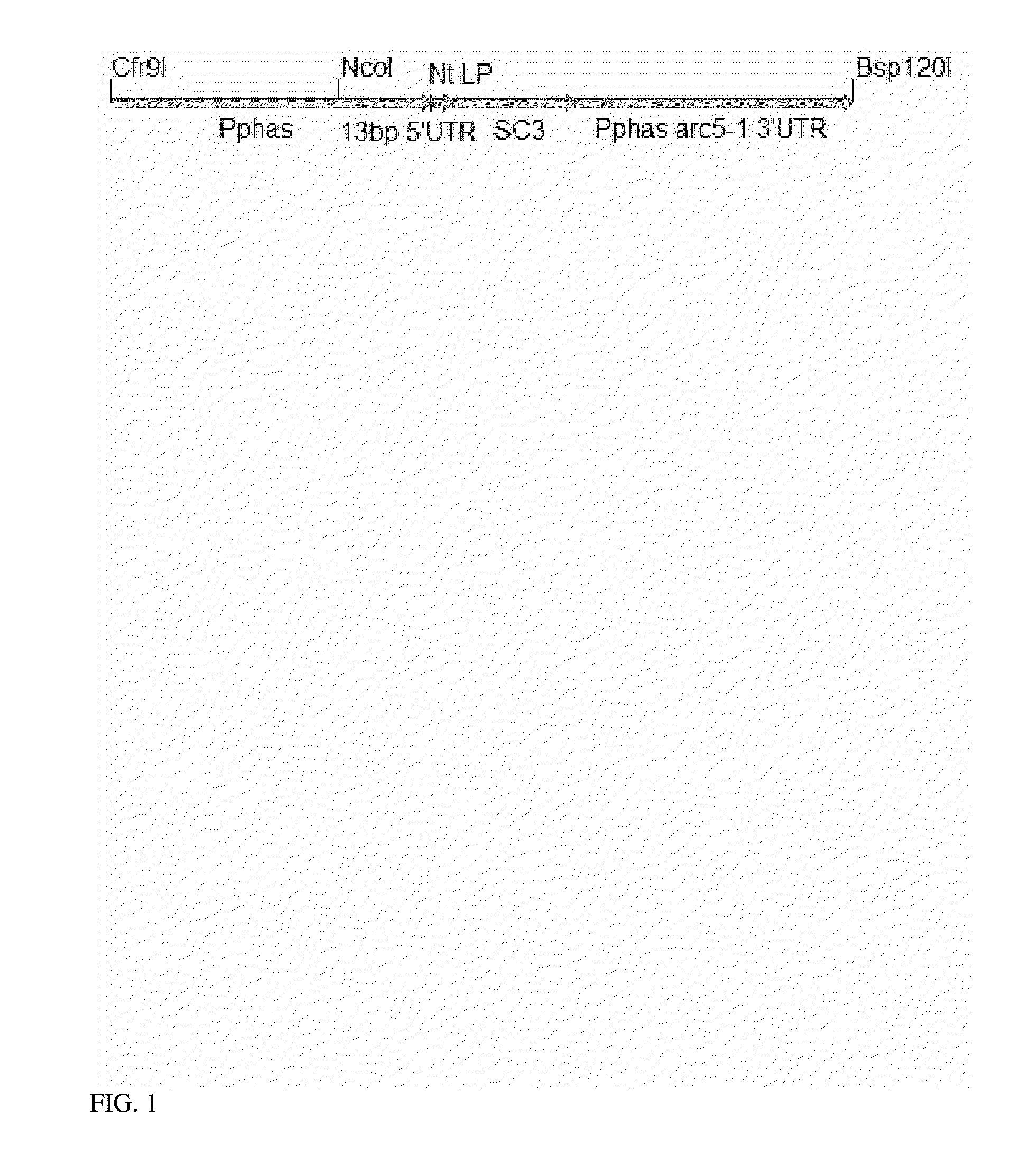Method for Protein Production in Doubled Haploid Plants
a technology of protein production and double haploid plants, which is applied in the field of clonallike isogenic production system of plant seeds, can solve the problems of low transformation rate, no transformants obtained, scarce examples of transforming double haploid plants, etc., and achieves high uniformity of product, and control of the expression level of heterologous gene products
- Summary
- Abstract
- Description
- Claims
- Application Information
AI Technical Summary
Benefits of technology
Problems solved by technology
Method used
Image
Examples
example 1
Cloning the Expression Vector for Production of Hydrophobin in the Seeds of Double Haploid Camelina Sativa
[0085]Seed specific expression cassette with Phaseolus vulgaris phaseolin promoter sequence, arcelin 5′ UTR and arcelin 3′ UTR was constructed as follows.
[0086]Genomic DNA for PCR amplification of Phaseolus vulgaris control elements is extracted from germinated seedlings with standard extraction methods. Alternatively, a kit such as Fermentas GeneJet Genomic DNA extraction kit is used. Phaseolus vulgaris phaseolin promoter sequence (Genebank accession number J01263; SEQ ID NO:1) is amplified with primers o1L (SEQ ID NO:10) and o13 (SEQ ID NO:11) from genomic DNA of Phaseolus vulgaris to correspond nucleotides 1 to 1470 of the promoter sequence. Short homology stretches with vector backbone containing Cfr9I restriction site at the 5′ end and with Phaseolus vulgaris arcelin 5′ UTR and expressed gene of interest at the 3′ end are introduced into the sequence with PCR primers. Synt...
example 2
Cloning the Expression Vector for Production of Tropoelastin in the Seeds of Double Haploid Camelina Sativa
[0087]Synthetic sequence for part of Arabidopsis thaliana seed storage albumin 2 signal peptide (2S2 SP) coded by nucleotides 80-118 of Genebank accession number NM—118849 and human tropoelastin (ELN) coding for amino acid sequence coded by nucleotides 170-2167 of Genebank accession number NM—001081753 (SEQ ID NO: 5 for synthetic gene, SEQ ID NO:6 for amino acid sequence) is obtained from GeneScript. The 2S2-ELN is amplified by PCR from GeneScripts vector pUC57 using primers o115 (SEQ ID NO: 14) and o117 (SEQ ID NO:15). 6× His-KDEL-Stop-fragment is made by PCR using two overlapping primers o116 (SEQ ID NO:16) and o118 (SEQ ID NO:17). 2S2-ELN and 6× His-KDEL-Stop-fragment have homologous overlap and are joined together in second PCR using primers o115 (SEQ ID NO:14) and o118 (SEQ ID NO:17). In addition to homology to ELN, 6× His-KDEL-Stop-fragment contain homology to arcelin 3′...
example 3
Cloning of the Expression Vector Targeting to Metabolic Engineering of Double Haploid Camelina Sativa
[0089]Agrobacterium Mediated Transformation with Lauric Acid-Acyl Carrier Protein (ACP) (EC 3.1.2.21-dodecanoyl-(acyl-carrier-protein)hydrolase) from California Bay (Umbellularia Californica)
[0090]Seed specific expression cassette with Brassica napus napin-A promoter sequence, with UcFatB1: lauric acid-acyl carrier protein (ACP) (EC 3.1.2.21-dodecanoyl-(acyl-carrier-protein)hydrolase) from California bay plant (Umbellularia californica) and UcFatB1 3′ UTR was constructed as follows: Genomic DNA for PCR amplification of Brassica napus napin-A promoter sequence is extracted from germinated seedlings with standard extraction methods. Alternatively, a kit such as Fermentas GeneJet Genomic DNA extraction kit is used. Brassica napus napin-A promoter sequence (Genebank accession number J02798; SEQ ID NO:7) is amplified with primers P-Bn-napA-F (SEQ ID NO:18) and P-Bn-napA-R (SEQ ID NO:19) ...
PUM
 Login to View More
Login to View More Abstract
Description
Claims
Application Information
 Login to View More
Login to View More - R&D
- Intellectual Property
- Life Sciences
- Materials
- Tech Scout
- Unparalleled Data Quality
- Higher Quality Content
- 60% Fewer Hallucinations
Browse by: Latest US Patents, China's latest patents, Technical Efficacy Thesaurus, Application Domain, Technology Topic, Popular Technical Reports.
© 2025 PatSnap. All rights reserved.Legal|Privacy policy|Modern Slavery Act Transparency Statement|Sitemap|About US| Contact US: help@patsnap.com

